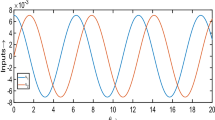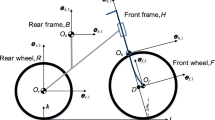Abstract
This article focuses on modeling and analyzing the dynamics of an autonomous unicycle. The equations of motion of the nonholonomic multibody system are derived using the Appellian approach, which enables the use of a minimum number of state variables and results in a system of low complexity. The final equations of motion consist of 8 first-order kinematic differential equations and 6 first-order dynamic differential equations. The stability of the open-loop dynamics is investigated and a PD-type controller with 3 input torques is proposed that enables the unicycle to stabilize its upright position and travel along a straight path. The performance of the closed-loop system is demonstrated via numerical simulations.







Similar content being viewed by others
Code Availability
The codes used to generate the data are included in the appendix.
References
Appell, P.: Sur une forme générale des équations de la dynamique (On a general form of the equations of dynamics). J. Reine Angew. Math. 121, 310–319 (1900)
Baruh, H.: Analytical Dynamics. McGraw-Hill, New York (1999)
Bloch, A.M.: Nonholonomic Mechanics and Control. Springer, Berlin (2003)
De Luca, A., Oriolo, G., Samson, C.: Feedback control of a nonholonomic car-like robot. In: Laumond, J.P. (ed.) Robot Motion Planning and Control, pp. 171–249. Springer, Berlin (1998)
De Sapio, V.: Advanced Analytical Dynamics: Theory and Applications. Cambridge University Press, Cambridge (2017)
Desloge, E.: A comparison of Kane’s equations of motion and the Gibbs–Appell equations of motion. Am. J. Phys. 54, 470–472 (1986)
Desloge, E.: Relationship between Kane’s equations and the Gibbs-Appell equations. J. Guid. Control Dyn. 10, 120–1222 (1987)
Desloge, E.: The Gibbs-Appell equations of motion. Am. J. Phys. 56, 841–846 (1988)
Gantmacher, F.: Lectures in Analytical Mechanics. MIR Publishers, Moscow (1970)
Gibbs, J.W.: On the fundamental formulae of dynamics. Am. J. Math. 2(1), 49–64 (1879)
Greenwood, D.T.: Adavanced Dynamics. Cambridge University Press, Cambridge (2003)
Halvani, O., Or, Y.: Nonholonomic dynamics of the twistcar vehicle: asymptotic analysis and hybrid dynamics of frictional skidding. Nonlinear Dyn. 107(3), 3443–3459 (2022)
Hamel, G.: Nichtholonome Systeme höherer Art (Nonholonomic systems of a higher kind). Sitzungsber. Berl. Math. Ges. 37, 41–52 (1938)
Horvath, H.Z., Takács, D.: Control design for balancing a motorbike at zero longitudinal speed. In: 15th International Symposium on Advanced Vehicle Control (2022)
Isomi, Y., Majima, S.: Tracking control method for an underactuated unicycle robot using an equilibrium state. In: 2009 IEEE International Conference on Control and Automation, pp. 1844–1849 (2009)
Kane, T.R.: Dynamics of nonholonomic systems. J. Appl. Mech. 28, 574–578 (1961)
Kane, T.: Rebuttal to “A comparison of Kane’s equations of motion and the Gibbs–Appell equations of motion”. Am. J. Phys. 54, 472 (1986)
Kane, T.R., Levinson, D.A.: Dynamics, Theory and Applications. McGraw-Hill, New York (1985)
Koon, W.S., Marsden, J.E.: The Hamiltonian and Lagrangian approaches to the dynamics of nonholonomic systems. Rep. Math. Phys. 40(1), 21–62 (1997)
Meijaard, J.P., Papadopoulos, J.M., Ruina, A., et al.: Linearized dynamics equations for the balance and steer of a bicycle: a benchmark and review. Proc. R. Soc. A 463(2084), 1955–1982 (2007)
Naveh, Y., Bar Yoseph, P., Halevi, Y.: Nonlinear modeling and control of a unicycle. Dyn. Control 9, 279–296 (1999)
Neimark, J.I., Fufaev, N.A.: Dynamics of Nonholonomic Systems. Translations of Mathematical Monographs, vol. 33. Am. Math. Soc., Providence (1972)
Niełaczny, M., Wiesław, B., Kapitaniak, T.: Dynamics of the Unicycle Modelling and Experimental Verification. Springer, Berlin (2019)
Ostrovskaya, S., Angeles, J.: Nonholonomic systems revisited within the framework of analytical mechanics. Appl. Mech. Rev. 57(7), 415–433 (1998)
Papastavridis, J.G.: Analytical Mechanics. World Scientific, Singapore (2002)
Pollard, B., Fedonyuk, V., Tallapragada, P.: Swimming on limit cycles with nonholonomic constraints. Nonlinear Dyn. 97(4), 2453–2468 (2019)
Qin, W.B., Zhang, Y., Takács, D., et al.: Nonholonomic dynamics and control of road vehicles: moving toward automation. Nonlinear Dyn. 110(3), 1959–2004 (2022)
Rodwell, C., Tallapragada, P.: Induced and tunable multistability due to nonholonomic constraints. Nonlinear Dyn. 108(3), 2115–2126 (2022)
Routh, E.J.: The Advanced Part of a Treatise on the Dynamics of a System of Rigid Bodies. Macmillan & Co., London (1884)
Ruan, X., Hu, J., Wang, Q.: Modeling with Euler-Lagrange equation and cybernetical analysis for a unicycle robot. In: 2nd International Conference on Intelligent Computation Technology and Automation, pp. 108–111 (2009)
Schoonwinkel, A.: Design and test of a computer stabilized unicycle. PhD thesis, Stanford University (1987)
Sheng, Z., Yamafuji, K.: Study on the stability and motion control of a unicycle: part I: dynamics of a human riding a unicycle and its modeling by link mechanisms. JSME Int. J. Ser. C 38(2), 249–259 (1995)
Suzuki, H., Moromugi, S., Okura, T.: Development of robotic unicycles. J. Robot. Mechatron. 26(5), 540–549 (2014)
Tallapragada, P., Kelly, S.D.: Integrability of velocity constraints modeling vortex shedding in ideal fluids. J. Comput. Nonlinear Dyn. 021, 008 (2017)
Teschl, G.: Ordinary Differential Equations and Dynamical System. Am. Math. Soc., Providence (2012)
Várszegi, B., Takács, D., Orosz, G.: On the nonlinear dynamics of automated vehicles – a nonholonomic approach. Eur. J. Mech. A, Solids 74, 371–380 (2019)
Voronets, P.V.: Об уравнениях движения для неголономных систем (On the equations of motion of nonholonomic systems). Мат. Сб. 22(4), 659–686 (1901)
Vos, D., Von Flotow, A.: Dynamics and nonlinear adaptive control of an autonomous unicycle: theory and experiment. In: 29th IEEE Conference on Decision and Control, pp. 182–187 (1990)
Voss, A.: Ueber die Differentialgleichungen der Mechanik (About the differential equations of mechanics). Math. Ann. 25, 258–286 (1885)
Yona, T., Or, Y.: The wheeled three-link snake model: singularities in nonholonomic constraints and stick-slip hybrid dynamics induced by Coulomb friction. Nonlinear Dyn. 95(3), 2307–2324 (2019)
Zenkov, D., Bloch, A., Marsden, J.: The Lyapunov-Malkin theorem and stabilization of the unicycle with rider. Syst. Control Lett. 45, 293–300 (2002)
Funding
Dénes Takács acknowledges the support of the Rosztoczy Foundation during 2020–2021. Dang Cong Bui acknowledges the support of the Vingroup Science and Technology Scholarship Program during 2021–2022. Gábor Orosz acknowledges the support of Hungarian Academy of Sciences within the Distinguished Guest Fellowship Programme during 2022.
Author information
Authors and Affiliations
Contributions
X. C. and D. C. B. carried out the analytical calculations as well as the numerical simulations. They contributed equally to this work. D. T. created some of the illustrations. D. T. and G. O. supervised the research and all authors participated in the writing of the manuscript.
Corresponding author
Ethics declarations
Ethical Approval
Not applicable.
Competing interests
The authors declare no competing interests.
Additional information
Publisher’s Note
Springer Nature remains neutral with regard to jurisdictional claims in published maps and institutional affiliations.
Appendices
Appendix A: Detailed expressions of accelerations
The components of the acceleration of the center of mass B and the angular acceleration of the body in (32) are
and
The components of the angular accelerations of the flywheels in (36) are
and
Appendix B: Elements of matrices in the linearized systems
The components of matrix \(A\) in (61) are:
the components of matrix \(B\) in (61) are:
the components of matrix \(\bar{A}\) in (70) are:
where
The polynomial in (71) is:
Appendix C: Eigenvectors of the open-loop system
When \({\omega _{\mathrm{b}}^{*}=\omega _{\mathrm{s}}^{*}=0}\), the eigenvectors corresponding to the nonzero eigenvalues (63) are
where \(A_{ij}, B_{ij}\) are defined in Appendix B.
Appendix D: Transfer functions for the open-loop system
When \({\omega _{\mathrm{b}}^{*}=\omega _{\mathrm{s}}^{*}=0}\), the transfer function from input torques \(M_{\mathrm{w}}\), \(M_{\mathrm{b}}\), and \(M_{\mathrm{s}}\) to angles \(\gamma \), \(\theta \), and \(\psi \) are:
where \(A_{ij}, B_{ij}\) can be found in Appendix B.
Appendix E: MATLAB code for the EoM derivation




Rights and permissions
Springer Nature or its licensor (e.g. a society or other partner) holds exclusive rights to this article under a publishing agreement with the author(s) or other rightsholder(s); author self-archiving of the accepted manuscript version of this article is solely governed by the terms of such publishing agreement and applicable law.
About this article
Cite this article
Cao, X., Bui, D.C., Takács, D. et al. Autonomous unicycle: modeling, dynamics, and control. Multibody Syst Dyn (2023). https://doi.org/10.1007/s11044-023-09923-7
Received:
Accepted:
Published:
DOI: https://doi.org/10.1007/s11044-023-09923-7




